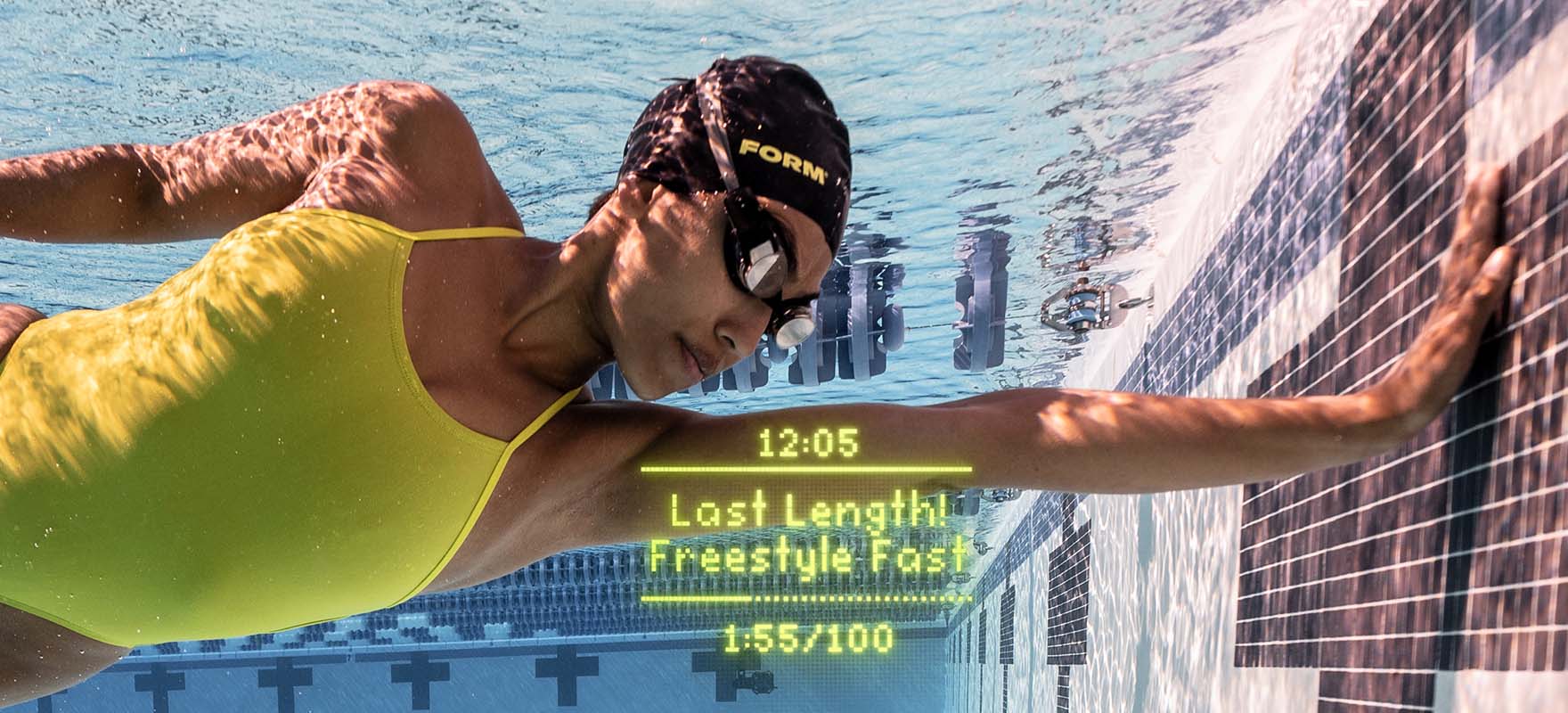Understanding and Improving Your Swim Pace
Success and improvement in swimming doesn’t only include moving as fast as you can—there’s a lot more to it. Most of us have experienced that shattering feeling of going out too fast and hitting a wall halfway through an interval, set, workout, or race. When you train and race like this, you miss out on getting the most out of your full potential—whatever your swim level. This is what pacing is all about; knowing how to distribute your effort across a specific period of time in order to maintain speed and optimize performance.
There’s no better way to start improving your speed and pace in swimming than with a FORM goggles. With FORM Premium features, you can also select from 1500+ coach-designed workouts and 30+ training plans designed to help you become a better swimmer based on your specific swim goals. Learn more about FORM goggles, or if you already have a pair, head to the FORM app to start a 30-day free premium trial*.
So, What is Pace?
Pacing is how you distribute your effort across your swim—whether that’s an interval, set, entire workout, or race. How you approach this, known as a pacing strategy, should be personalized to you.
Your individual swim pacing strategy will depend on your swimming level, the distance you’re swimming, what effort level you’re swimming at, and the amount of rest you’re taking. During a structured swim, these parameters are prescribed to you and are arranged in different ways to create specific training adaptations.
Learning how to pace effectively can drastically change your performance, which gives you flexibility to swim a variety of workouts at different efforts and increases your overall enjoyment of swimming!
How is Swim Pacing Different?
You might be thinking, “I already know how to pace, I‘ve heard it all before”. Pacing is an important part of all endurance sports, but pacing in swimming is different. There are many things that can impact your pace during a swim, which is part of what makes the sport so unique!
From technique, to fitness and endurance, rest and effort, distance and body composition… even your swimsuit! Each and every variable can inevitably have an impact on your pacing strategy throughout a swim. While this may seem daunting at first, many of these can actually be used to your advantage to become a truly dynamic swimmer.

Below, we deep dive into the top variables that impact your swim pace:
1. Drag/Resistance:
Water is an incredibly unique environment for sport. Being ~800 times denser than air (IOPSpark, 2022), the technical challenge of moving through water as efficiently as possible is ever-present. As you progress, you’ll experience drag in a different light. The faster you’re swimming, the more drag force you need to overcome. Because of this, having a more streamlined technique is important to get the most out of your effort during stronger swimming.
2. Technique:
Technique is the driving force behind energy efficiency— it’s your ability to limit the amount of drag you create as you swim, all while conserving as much energy as possible. Drag is always working against our bodies in the water, but there are ways we can reduce that drag to increase our efficiency. This means we can move further, and faster, with less energy. And who doesn’t want that?
There are a few different types of drag, but frontal drag is the easiest to reduce with corrections to your overall technique. Some things to keep in mind to reduce drag are:
- A streamlined body position starts with your head, hips, and heels in a line at the surface of the water.
- Keep your kick narrow with your feet close together and kick continuously inline with your body.
- Maintain a stable head position, rotating along the long axis of your body to breathe, instead of lifting or moving your head up and out of the water.
- Perfect your body roll to lengthen along the long axis of your body, to us the full power of your arm stroke for maximum efficiency.
While small tweaks to our stroke may take some conscious thought and practice, they can make some of the greatest differences to our overall pace and enjoyment of swimming. No matter what level you’re at, everyone can benefit from working on their technique.
3. Fitness:
By increasing your cardiovascular fitness and muscular endurance, you’ll be more equipped to sustain a consistent pace, swim consistently over longer distances, and even increase your pace overtime. Keep in mind: increasing your pace is only desirable when you can hold that pace for the entire interval—to do this you need to be patient and consistent with your training.
Like all good things, there is no quick secret to success; the more you show up, the more your capacity for longer and stronger swimming will grow. Lucky for you, we have fitness plans and workouts that you can use to create a good routine to achieve your swim goals. Learn more about get your swim routine started with a FORM goggles. If you already have FORM goggles, head to the FORM app to start a 30-day free premium trial*.
4. Consistency:
When it comes to pacing, consistency is key. The ultimate pace goal is to limit mid-set fatigue and stay in control, so you don’t end an interval or set fully exhausted.
To do this, you need to find your optimal pace for a given distance and maintain it throughout. It isn’t about going out fast when you have energy or starting slow to save your energy for the last lap. It’s about identifying and hitting the same pace, lap over lap, till you reach the finish line.
Pace consistently with FORM’s swim data and analytics
- With the FORM app, getting familiar with your pace is right at your fingertips! Take a look at your split times and set an attainable goal that you can hold consistently in your next workout. Look at your past swims to see your progress over time.
- For a single repeat (e.g. 100m), the bars of your swim tile should all be level; reflecting a consistent pace, lap-over-lap. You can also look at your splits within an interval to see the difference in time.

Get the Most Out of Your Swim Workouts
We’ve talked about pacing within an interval, but what about interval to interval throughout a workout? This is where understanding the dynamic relationship between rest, effort, and repeat distance comes into play to make your training specialized, effective, and fun!
- Rest: Rest gives you an opportunity to recover and recharge for whatever comes next. If you have trouble maintaining the same pace from one interval to the next, it may be because you aren’t taking the appropriate amount of rest for the effort level you’re swimming at.
- Effort: Swimming at an easy effort will require less rest. As you continue to move from easy to moderate to stronger swimming, the amount of rest required to maintain that pace will increase.
- Repeat Distance: Swimming longer distance repeats are typically coupled with lower efforts that can be sustained over the course of the repeat. As you work up to longer repeats, start at an easy pace and progress to moderate. If you want to swim fast and max effort intervals, start with shorter 25m repeats, and work your way up to 50s and 100s.
The amount of rest required to maintain a certain pace will be dynamic. As you become more efficient in the water and increase your swimming fitness, you’ll be able to maintain a faster pace with less rest or maintain that pace for longer repeats.
Everything is interconnected. Improving your technique and increasing your fitness, or changing up your distance, effort and rest, will all inevitably have an effect on your pace. And what’s better, is all of this can come from practice, patience and perseverance!
If you'd like to learn more about swim pacing, check out these 7 Pro Tips on How to Swim Faster in the Pool!

Use FORM to Your Advantage
Swimming is technically complex and takes time to master, but that’s where we come in! Improve your pace and become a better swimmer with FORM premium.
As a member, you’ll have access to:
-
Real-time metrics & In-app Swim Data
- Use real-time metrics in your goggles to know your pace after each interval (50 or 100m/yd), as well as your distance per stroke to maintain consistent pacing. Post workout, check your in app swim data for the full rundown on.
-
FORM Plans and Workouts
- Follow a training plan designed by our expert swim coaches. With 20+ options to choose from, swimmers at all levels will improve and efficiently work towards their goals.
- Plans for pace improvement:
- Boost Your Cardio
- Improve Your Pace
- Boost Your Endurance
- Pick from 1,000+ workouts based on what kind of pacing strategy you want to work on; whether you’re looking for sprints or long endurance sessions.
- Pacing focused workouts:
- Learning to Pace: Low Intensity - Endurance
- Find Your Pace: Moderate Intensity - Power
- Challenging Pace: High Intensity - Endurance
-
Custom Workout Builder
- Create your own workout, input one from a coach, or edit one of ours to meet your own pacing goals.
Join now to improve your pace with FORM premium—includes worry-free, 30-day return guarantee.
Already have FORM goggles, but don’t have access to our full range of features? Head to the FORM app to start a 30-day free premium trial*.
*30-day free premium trial is only valid for one-time use for new members who have previously purchased FORM goggles.
Pressure and density of Air. IOPSpark - Institute of Physics. (2022). Retrieved August 31, 2022, from
https://spark.iop.org/collections/pressure-and-density-air#:~:text=Air%20has%20a%20density%20of,barometer%20is%20about%2010%20m.










